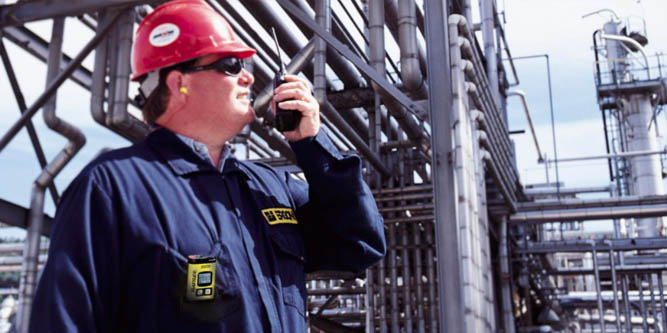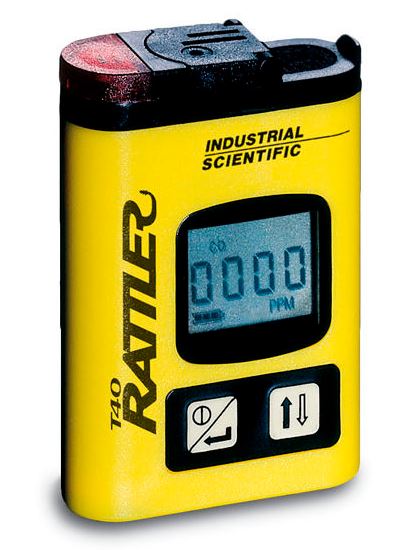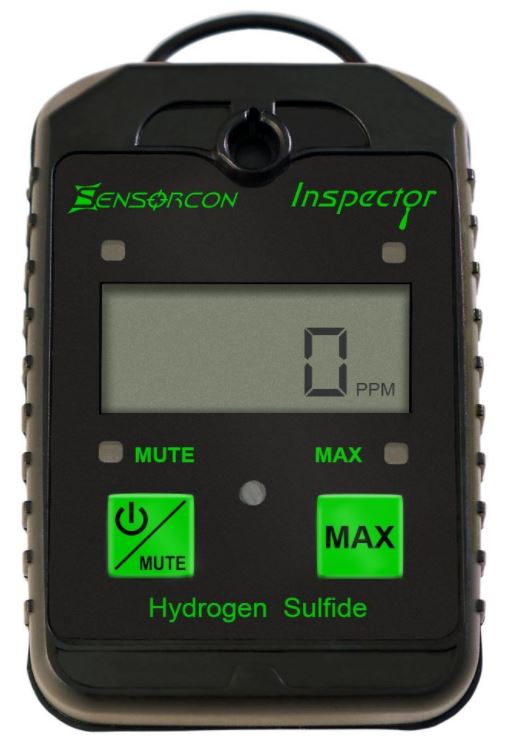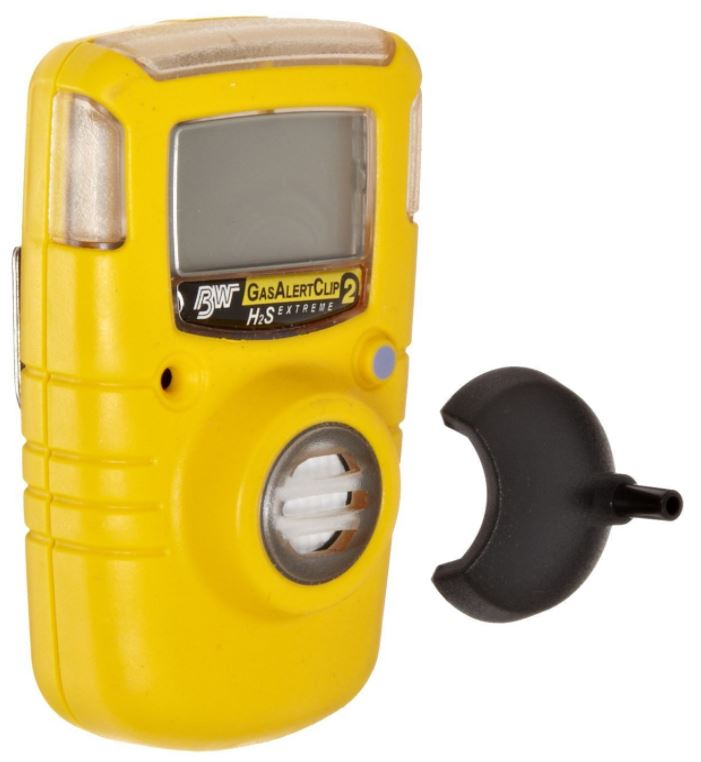Hydrogen sulfide (H2S) is a colorless gas. In spite of being essentially invisible to the naked eye, H2S is easily recognizable because it smells like rotten eggs. Lower levels of exposure usually only create minor health problems, like shortness of breath, sore throat, anxiety, or a cough. However, greater levels of exposure can lead to serious injury and death. Health issues aside, H2S is a flammable gas that can cause explosions or large fires.
Anytime you’re working around a dangerous gas, using a gas detector is critical to ensure safety. For the sake of H2S, that means a using a hydrogen sulfide monitor that’s capable of alerting you anytime gas levels become dangerous, but not necessarily every single time even a trace amount of the gas is detected. The human nose is a fairly sensitive instrument, and it can detect even a small amount of hydrogen sulfide. If you’ve got a typical sense of smell, then you’ll have no problem smelling traces of H2S quantities in the air, even when they’re as tiny as 0.03 parts per million (ppm.)
A 5-10 ppm, outcomes include the kind of relatively minor illnesses listed above. At 5-30 ppm, the gas will noticeably agitate your eyes. And at 100ppm, gas levels have become high enough to be immediately dangerous to life. Our noses are sensitive, but they’re simply aren’t equipped for the task of detecting if hydrogen sulfide is present in safe levels.
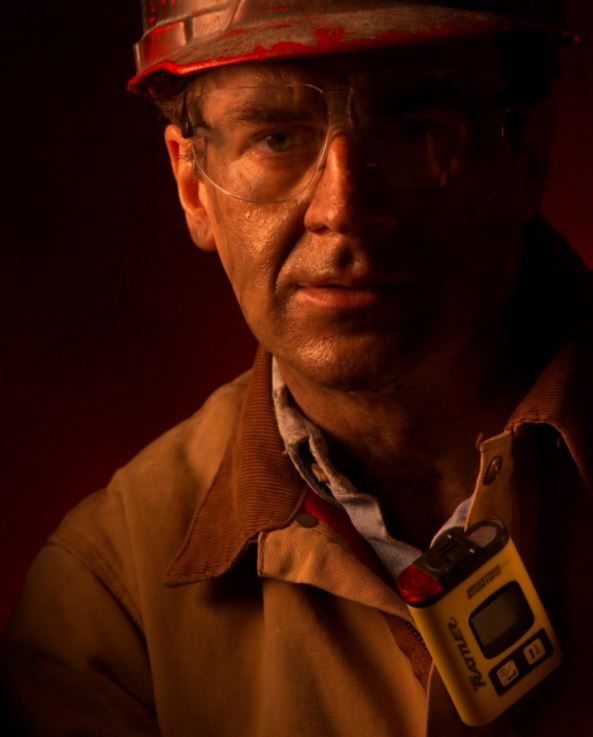
Choosing the Right H2S Monitor
Whenever you’re working around H2S or another dangerous gas, monitoring air quality is critical. Because the relatively small range between safe and unsafe levels, HS2 can swing from safe levels to dangerous levels in an instant. Consequently, anyone and everyone working around this gas should have access to perpetual monitoring equipment. Keeping tabs on H2S may also be important for preventing fire, will also corrosion, legal penalties, and death. But what’s the difference between a good hydrogen sulfide monitor and a great one?
Alert Systems
The most important aspect of any H2S monitor is its alarm system. Most H2S sensors are rigged with multiple alarms for redundant protection, making them well equipped for detection in nearly any kind of environment. Placed in a confined space where workers are all nearby, warning lights or to her visual displays can be highly effective at giving alert. But for larger areas where employees are spread, sirens may be more effective at alerting nearby inhabitants. For very loud conditions, individual units that support vibration may be necessary.
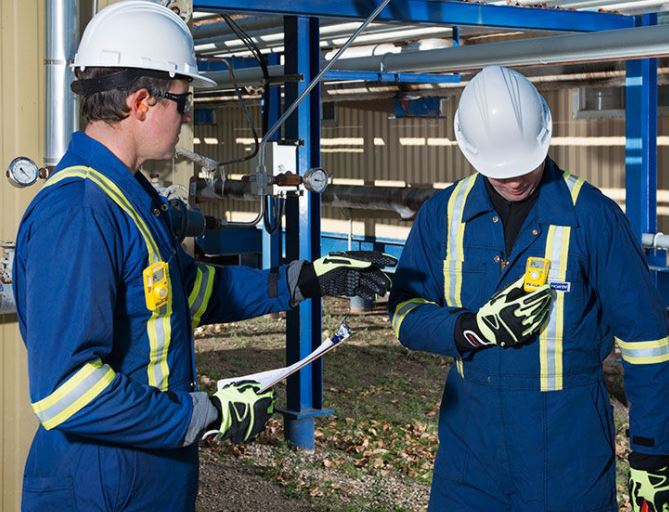
Types of Sensor
Alternatives like lead acetate tape gas detectors have bene used for decades, however they’re vulnerable to interference and they’re not going to give you the kind of rapid responses that you need from a portable detector.
H2S monitors are largely a choice between gold film sensors or electrochemical detectors. Gold film devices use an internal pump to pull ambient air over an internal sensor. The sensor proceeds to absorb any H2S present in the sample, and experiences a change in electrical resistance proportional to the amount of H2S in the air. For laboratory testing, gold film sensors are the gold standard. However, for practical use in real settings, they tend to be far too expensive and immobile to be effective.
In the case of electrochemical detectors, your sensor is home to a bundle of electrodes which are sheathed in a permeable membrane. That membrane allows sample air to pass into the cell, causing either oxidation or reduction. That chemical change is then measured so the device can determine the amount of H2S in the air. The result is relatively rapid response times, accuracy, sensitivity, and ultimately timely alerts for dangerous H2S levels.
Accurate and Reliable Readings
Because small differences in H2S levels can become deadly, you need accurate readings to warn you about minute changes in the air. But all measuring equipment gradually loses calibration over time, and H2S detectors are no exception. You may want a detector that allows you to calibrate the machine. Calibration can be somewhat difficult and may require special training and an aftermarket calibration kit. Alternatively, some companies allow you to return their detector to be calibrated in exchange for a small fee.
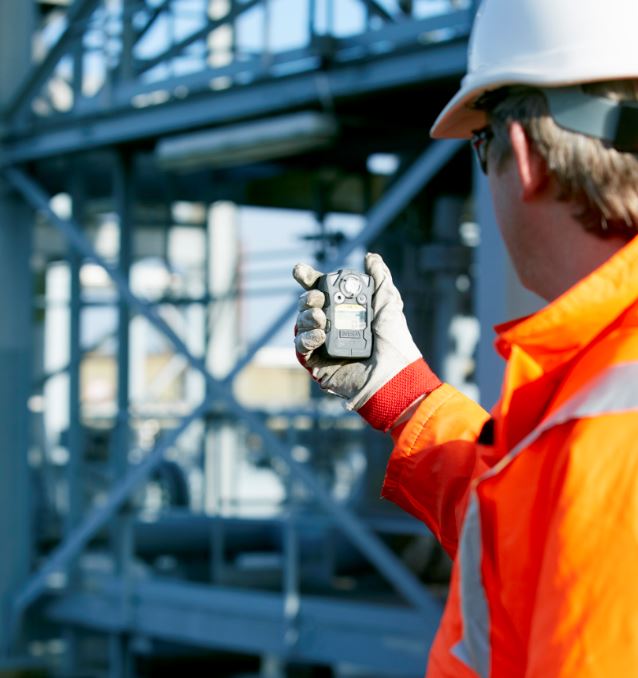
Fixed Life vs. Lasting Monitor
Using an H2S monitor typically involves ongoing maintenance, including battery changes and calibration. But calibration involves time, effort, expertise, and possibly an aftermarket calibration kit. For most hydrogen sulfide monitors, you’ll find calibration needs to be carried out at least twice per year. That can become tedious and time consuming, but essential for a task that helps safeguard lives.
Some people may want a monitor they can rely on without having to think about whether or not the device has been recently calibrated, if calibration was done accurately, or if the batteries will last all day. For that purpose, many H2S monitors use sensors with fixed lifespans.
These devices don’t need to be maintained or calibrated in any way during their lifespan. You can rest easy knowing the results you’re getting are correct, and you don’t have to tryst in the calibration skills of whichever technician last handled the instrument. However, after a fixed period of time these devices die and need to be replaced.
Portability
When you’re dealing with smaller and more confined spaces, H2S gasses can shoot up to dangerous levels in an instant. Industrial businesses use portable monitors as their standard because they’re small enough to be clipped on a belt, but accurate enough to give timely warnings to safely evacuate an area. But what one person calls portable may seem like a brick to another person. Paying attention to the specific weight and dimensions of an H2S monitor can help you know if its portability is more like an MP3 player than a backpack.
T40 Rattler Portable H2S Monitor
The T40 Rattler has automatic alarms that can be calibrated to be triggered at safety parameters of your own choosing. It uses a maintenance-free design that’s built specifically for H2S, so you’re not paying extra to measure gasses you’re not concerned about. All in all, it’s an inexpensive if overly simple solution to the problem of H2S monitoring.
Alarms & Accuracy
The Rattler continuously provides ambient readings on its LCD, and will start shooting off alarms the moment gas concentrations exceed preset low or high levels. Those levels and alarm set points are fully user adjustable to ensure the Rattler can work for your specific circumstances. Like you want from any decent measuring tool, you’ll also find a peak and hold feature to keep the highest readings during measurement, which can be particularly useful information for review after you’ve escaped to safety.
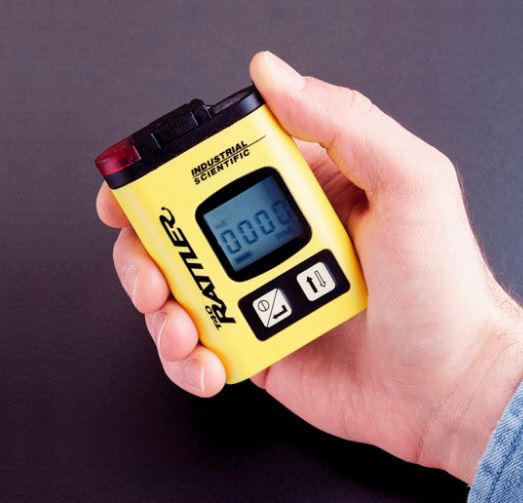
Build & Features
The Rattler uses a highly visible bright yellow casing composed of an impact-resistant composite that also provides protection from radio frequency interference. It weighs only 3.5 ounces, and uses a slim 3.3 x 2.3 x 0.75-inch design which is small enough to clip onto a belt.
Even though it has a compact size, the Rattler supports many features typically found only in larger monitors. For example, it has a full LCD, a vibrating alarm, and both visual and audible alarms. The front of the device has only two buttons, which is a clutter-free design to maintains simple operation. You can expect 1,500 hours of life off a single AA battery, which should last nearly as long as the included two-year warranty.
Sensorcon Hydrogen Sulfide Detector and Meter
Sensorcon’s H2S monitor has an emphasis on high sensitivity, and extra support for aquatic environments. Like the T40 Rattler, this monitor uses and electrochemical sensor, but with a design that’s equipped to handle momentary submersion. The IP67 waterproof rating makes this monitor perfect for boats and other wet environments. And like the Rattler, Sensorcon has included continuous monitoring of H2S concentrations, so you can keep a close eye on gas levels at during given moment.
Alarms & Accuracy
Sensorcon’s H2S monitor is a fully serviceable device that’s equipped for jobs now and in the future. It measures down to as little as 1ppm with a modest accuracy of +/- 10%. The device has presets for dangerous levels set at 10 ppm or 15 ppm, but those levels can be fully adjusted wherever you see fit. Both high level and low level alarms will result in visual and audible warnings, but no vibration. It supports a full 0 to 200 testing range that’s ideal for circumstances that require testing extremely high H2S levels.
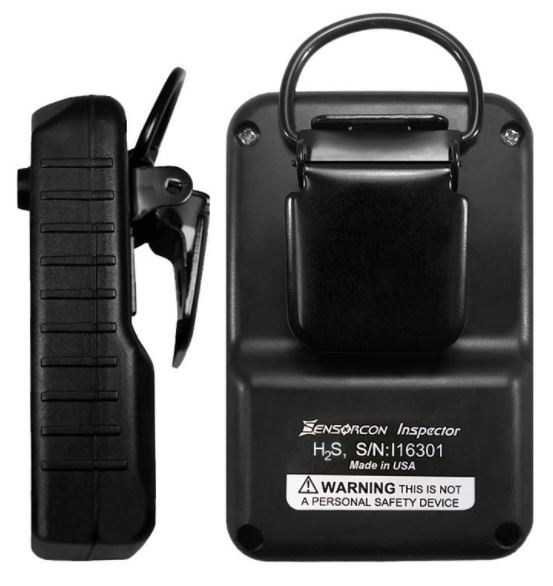
Build & Features
Like most H2S monitors, this sensor requires calibration twice a year. To ensure you don’t forget when calibration needs to occur, there’s an internal meter that can tell you when you’re due. If you don’t calibrate, you can expect a considerable 10% shift in accuracy each year. If you’re not confident in your ability to calibrate, you can send in the device for service through Sensorcon.
This H2S monitor includes a steel alligator clip with loop for attachment, but this monitor is clearly not intended to be a personal safety device. Rather, it’s intended to be used as an inspection tool that can be used for mobile monitoring of H2S. It’s considerably bulkier than similar devices, with a 5 x 3 x 2-inch design that weighs about six ounces.
BW Technologies HS2 Monitor
Rather than creating a permanent solution, BW Technologies’ H2S monitor is a 2-year detector. It makes use of an electrochemical cell that’s powerful and accurate at monitoring for H2S levels for about two years with zero support. After its two years are up, you’ll have to replace the device. And the supported 0 to 100ppm measuring range is more than enough for ensuring safety.
Alarms & Accuracy
This monitor supports vibration, audio, and visual alarms that can alert you anytime H2S reaches preset levels for low and high settings. The LCD is a full alphanumeric screen you can alter the alarm set points, see maximum recorded values, and the amount of life remaining in the detector. For personal safety, this monitor uses a single push button operation that’s impossible to screw up.
The device comes preloaded with 10 ppm and 15 ppm low/high settings, which can be adjusted to whatever levels you need to test for. One interesting feature to note is that the low alarm is quite distinct from the high alarm. The low alarm will create one beep, flash, and vibration per second. For high alarm conditions, all of those rates double.
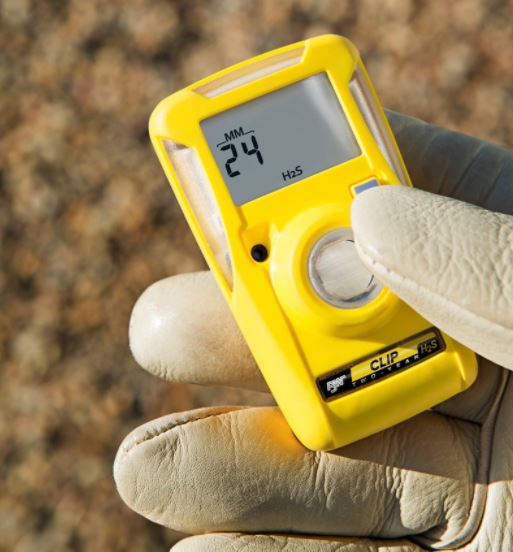
Build & Features
BW Technologies’ detector monitors maximum gas exposure as well as the amount of time exposed to that gas over the past 24 hours, and that data is retained for the 10 most recent exposure events. For added connectivity, you’ll find your data can be transmitted through an infrared sensor to a thermal printer, or connected through USB adapter to your computer.
To help guarantee accurate performance, this detector tests its own lithium battery every two hours. The LCD prompts you to start a full function test every day. That self-test prompts the device to check its circuitry, sensor, and battery. And for safety, the detector will shut off after five battery failures, or three test failures.
This kit includes a back-mounted alligator clip, ideal for attaching the detector to a boot, lapel, or elsewhere on the body. The audible alarm is a fairly loud 95 dB, and the 3.2 x 2.0 x 1.1-inch build keeps this device highly portable while weighing just under three ounces.
Choosing Between 3 Portable Hydrogen Sulfide Monitors
If you’re looking for a long-lasting and accurate personal safety device, and you don’t mind doing your own calibrations, then you want the T40 Rattler. Sometimes even loud alarms aren’t enough to catch someone’s attention. Noisy work environments often demand hearing protection, which makes vibration a safety feature that can’t be underestimated. It’s highly portable, safe, and a relatively inexpensive solution to a dangerous problem.
If you don’t want to have to think about calibration and maintenance, then you want the BW Technologies HS2 monitor. It’s build with industrial settings in mind, and provides all the necessary accuracy, portability, and alarms necessary for those environments. After two years you’ll need to replace the device, but you won’t have to worry about trying to train someone to calibrate a monitor. This monitor is ideal for tanneries, paper mills, petroleum refineries, and other places where portable H2S monitoring needs to be consistently taken seriously.
And if you’re looking for portable H2S testing for extremely high gas levels, or other testing that doesn’t involve personal safety, then you want Sensorcon’s H2S detector. Sensorcon is also the go-to choice for most applications involving water. The only considerable drawback to its immense 0-200 ppm testing range is you’ll have to calibrate the device twice per year.
Meet Ry, “TechGuru,” a 36-year-old technology enthusiast with a deep passion for tech innovations. With extensive experience, he specializes in gaming hardware and software, and has expertise in gadgets, custom PCs, and audio.
Besides writing about tech and reviewing new products, he enjoys traveling, hiking, and photography. Committed to keeping up with the latest industry trends, he aims to guide readers in making informed tech decisions.

